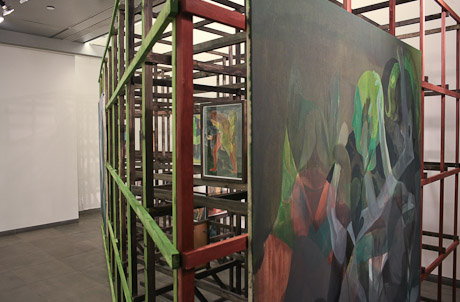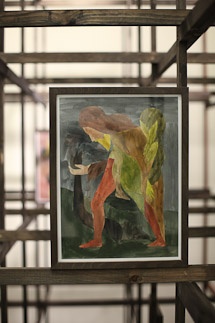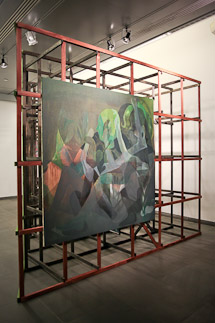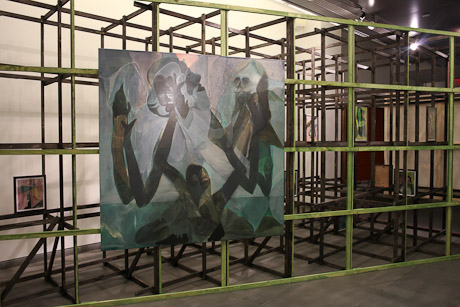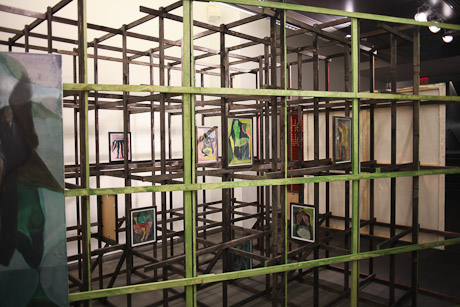| the eyes are not here,there are no eyes here 2011
MATERIALS:
wood, collage, paintings
size variable
EXHIBITION:
5ROOMS
Austrian Cultural Forum, NY
EXCERPTS FROM THE INTERVIEW
David Harper & Daniel Domig
DH: Throughout your practice, the display of your painted canvases (and in this case framed works on paper as well) appear often in the context of a sculptural structure. How and why did this strategy for display come about?
DD: The first Installation I made with paintings was during my time at the academy. Every year the academy organizes several days in which students are able to show their work and visitors can come and walk around the studios. The whole thing is rather odd, because most students try and transform their (often) small and dirty working space into a clean and gallery-like stand. So the year I was asked to participate I was challenged by that very strange situation and responded by building the piece " If all else fails", which was essentially comprised of all my finished and unfinished paintings clamped into a mini house. It had all my stuff ( record player, chair, wine, paints) inside of it and visitors were welcome to sit and rest from all the art.
After my studies I realized I wanted to somehow bridge this gap between the studio and the exhibition space. And building installations on site allow me to inhabit that space and practically occupy it as my temporary atelier. Eventually, a big part of what people see when the piece is finished, is that there is spontaneity and improvisation to it, that only comes from submitting to the space and working inside of it.
Can you tell me about your decision to build a structure which separated or isolated the viewer in one corner? Was that isolation important to understand the work as a whole or more to encourage viewers to actually see the individual parts?
Before I began building the piece I had a fairly detailed idea of what it should be. I usually prepare by doing several drawings and visual rearrangements of the installation. However, during the setup-process I started reacting more impulsively towards both the space and the piece. By way of improvising on my initial concept I began overriding certain details, as well as leaving out things I had originally thought to be essential. This was how the corner came about: Successful Failure!
In its function to understanding the work, I imagine it creates an interesting moment for the visitor as he somehow "stands in" for the missing piece of the construction. Of course he has better view on both the individual works and the complete installation, but it is the fact that the visitor becomes less a perceiver and more an integral part of the work which I find fascinating. Ernest Becker uses the term "protean self" to describe our physical extensions into external objects of all sorts. And because these themes accompany my working process early on, I appreciate how they show up in the finished piece.
You are by far the most figurative artist in the exhibition, but even so, the narrative of your work is difficult to decipher. Can you explain the narrative (if there is one) and is it important for the works to tell a story?
I find it difficult to respond to this question because the terminologies (figurative, narrative,…) have become over- and often mis-used. They are in many ways imprecise and inapt to speak truthfully about painting today.
However, until I find fitting definitions I would like to respond to the idea of the narrative and more importantly its' decoding. Here I believe we find one of the major problems of experiencing painting today. It is no longer received for what it is but translated into a more digestible (theoretic) form. It is quickly interpreted and decoded and read, but people seem to have lost the ability of looking. What once seems to have been the viewer in front of a piece of art has become the comprehender in front of a piece of information. This ability to look without seeing, to concentrate without understanding is a natural ability that we begin to loose once we devote our attention exclusively towards things which make sense. What is lost is not only the sense of childlike wonder, but we miss the engagement with mystery which lies at the core of any relevant encounter (interpersonal, artistic, nature,…). So if there is narrative in the work I hope it is a distinctively human and therefor universal one. Any story worth reading will somehow be our own. On the deepest and most primal level there is no significant difference between your fear and mine, your hope and mine, your loss and mine. If the roots of the artistic narrative do not reach that deep, then any storyline or meaning the artist had hoped to animate will remain forever ineffectually on the surface on the canvas.
What do you think about the notion that there is/has been a return of artists to surreality in painting and sculpture, especially in opposition to the recent trend of collage and assemblage (which in a way automatically connotes reality, due the material)? Do you think of your work as surreal?
Yes, and no. Again this boils down to the interpretations of the word surreal. But in the sense that "surreal" painting (like, the new polish school) renders a more mysterious and obscure side of reality, I would gladly be branded by that label.
|


